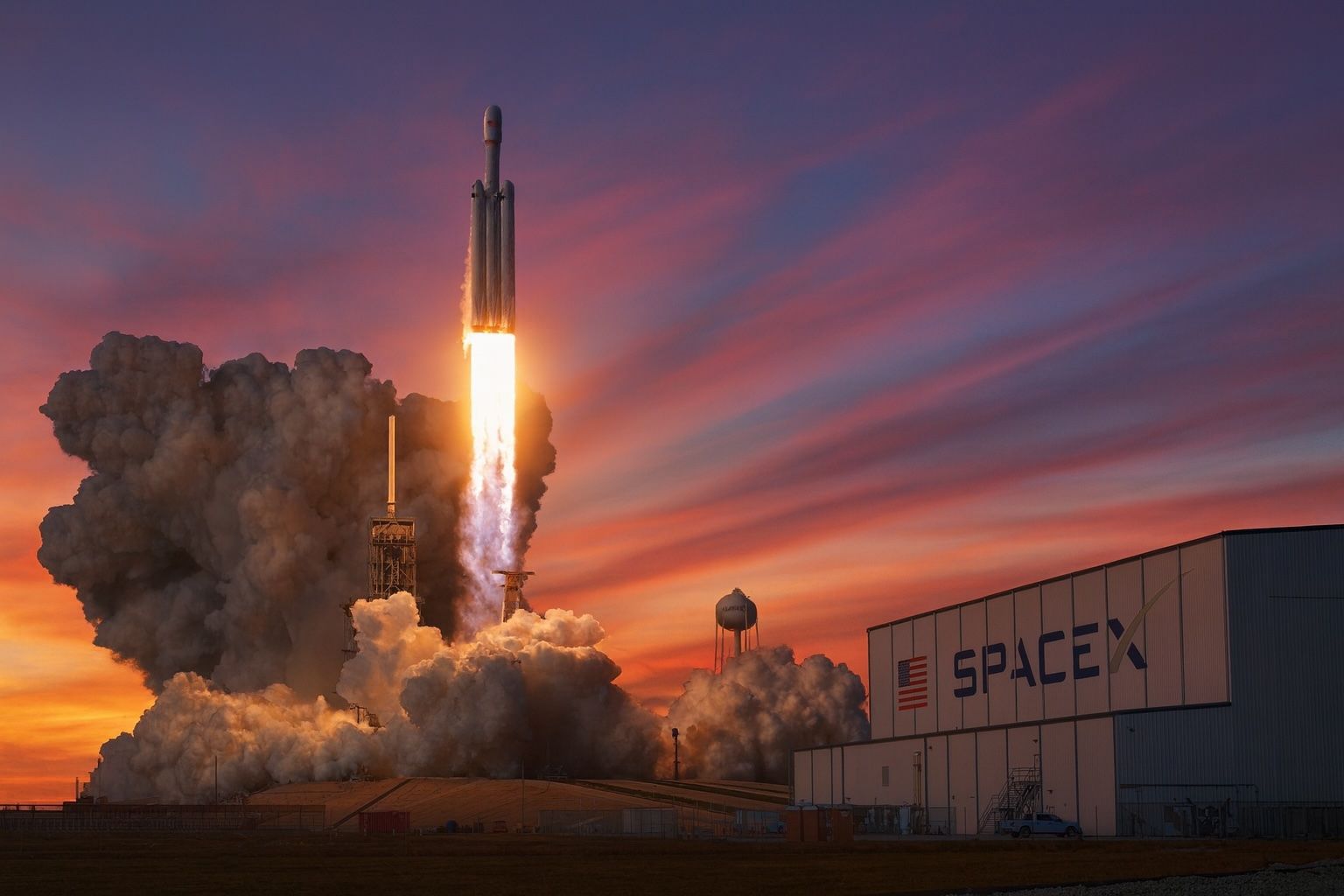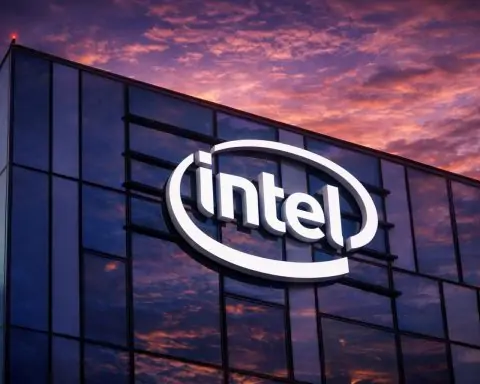- Starship Flight 11 Scheduled: SpaceX targets Oct. 13 for the next Starship launch (Flight 11), which will be the final flight of the current Starship “Version 2” design [1] [2]. The mission aims to test new booster landing techniques and deploy more Starlink satellites as SpaceX pushes toward full reuse of the 400-foot mega-rocket.
- Record Falcon 9 Launch Pace: SpaceX’s 125th Falcon 9 launch of 2025 lifted 28 Starlink satellites on Oct. 3, marking an unprecedented launch cadence – over 70% of this year’s Falcon 9 flights have been dedicated to Starlink [3]. September alone saw 16 launches, including an 8-launch month at Vandenberg Space Force Base [4], highlighting SpaceX’s rising tempo despite weather delays.
- Starlink Constellation Milestones: The Starlink network now exceeds 8,500 active satellites, accounting for roughly two-thirds of all operational satellites in orbit [5]. The service, with an estimated 8 million users, remains SpaceX’s top revenue driver [6] [7]. SpaceX projects Starlink to generate around $15.5 billion in annual revenue [8], fueling the company’s staggering valuation of about $400 billion [9] [10].
- Amazon’s Kuiper Launched by SpaceX: In a twist of “coopetition,” SpaceX prepared to launch Amazon’s Project Kuiper satellites on Oct. 8 – the third batch of this Starlink rival’s prototypes [11]. The Falcon 9 Kuiper mission, delayed to Oct. 8, underscores SpaceX’s role as a launch provider even for competitors’ constellations [12] [13]. Amazon secured JetBlue as a future in-flight internet partner, aiming to challenge Starlink’s airline Wi-Fi deals by 2027 [14].
- New U.S. Military Contracts: The U.S. Space Force awarded SpaceX five new national security missions (worth $1.142 billion combined) as part of the latest launch contracts, including four Falcon Heavy launches between FY2027–FY2029 [15] [16]. SpaceX will handle the lion’s share of these secretive military and intelligence payloads, reflecting its dominance as the “Requirement 1” provider, while rival Blue Origin received no missions this round due to its New Glenn rocket still awaiting full certification [17] [18].
- Regulatory & Legal Greenlights: A U.S. federal judge dismissed an environmental lawsuit against the FAA’s approval of SpaceX’s Texas Starship site, siding with regulators and SpaceX on Sept. 15 [19] [20]. Meanwhile, the FAA released a draft environmental assessment for expanded Starship operations at Boca Chica, with public comments open through Oct. 20 [21] [22]. A planned Oct. 7 public hearing on the assessment was canceled due to the federal government shutdown, adding uncertainty to Starship’s regulatory timeline [23] [24].
- Infrastructure Expansions: SpaceX is rapidly upgrading facilities. At Starbase in Texas, a second Starship launch pad (Pad 2) has undergone successful water deluge system tests to prepare for higher flight rates, recycling water to enable faster re-launch attempts [25] [26]. In Florida, construction continues on a Starship launch complex at Kennedy Space Center (LC-39A) – with flame trenches, towers, and tank farms rising – expected to be ready by mid-2026 [27] [28]. SpaceX is also eyeing Launch Complex 37 at Cape Canaveral for future Starship operations once environmental reviews and leases are secured [29].
- Elon Musk’s Bold Predictions: Fresh off Starship’s 10th test flight success in August, CEO Elon Musk declared he is “fairly confident” Starship will be operational by 2026, delivering 100+ tons to orbit and achieving full reusability of both booster and ship [30] [31]. Musk revealed that Starship Version 3 – a taller, more powerful iteration with next-gen Raptors – will debut next year, aiming to catch the Super Heavy booster and even the Starship upper stage with the launch tower’s steel “chopsticks” [32] [33]. These ambitious goals come with Musk’s usual optimism: he noted SpaceX will attempt the first mid-air catch of Starship on test flights 13–15 if Version 3 performs well [34].
- Market and Industry Outlook: SpaceX’s breakneck progress continues to reshape the space industry. The company completed over 125 launches in under 10 months of 2025, giving it an estimated 80–90% share of commercial orbital launches. Analysts credit Starlink’s explosive growth – now over 7,500 satellites in service orbit [35] – for driving SpaceX’s valuation past all other private companies [36] [37]. Competitors are scrambling: United Launch Alliance (ULA)’s new Vulcan rocket has begun flying but at a slower cadence, and Blue Origin hopes to launch its second New Glenn rocket by late October or early November [38] to prove it can eventually fulfill its contract share. Even Europe’s delayed Ariane 6 and various startups face pressure as SpaceX’s reliability and reusable rockets increasingly undercut legacy launch providers. Industry experts caution that Musk’s timelines can slip, but few doubt SpaceX’s transformative impact.
Now, let’s dive into the details of each development from October 1–10, 2025, and what they mean for SpaceX, its competitors, and the future of spaceflight.
Falcon 9 Launch Frenzy and Mission Highlights
[39]SpaceX began October with Falcon 9 rockets flying at an unprecedented pace, underscoring the company’s capability to maintain a rapid cadence. On Oct. 3, a Falcon 9 from Vandenberg SFB completed SpaceX’s 125th launch of 2025, lofting 28 Starlink V2 Mini satellites to low Earth orbit [40] [41]. The booster (serial B1097) landed on the Pacific droneship Of Course I Still Love You minutes later, marking SpaceX’s 514th successful booster recovery to date [42] [43]. This mission was notable not just for its payload, but for a quirky bit of launch trivia: it was the third Falcon 9 in a row launched from the West Coast – the first time SpaceX has ever flown three consecutive missions out of Vandenberg without an interleaved Florida launch [44].
Why the West Coast streak? It appears Atlantic hurricanes played a role. In late September, storms like Hurricane Humberto and Imelda churned up rough seas and unsafe conditions around Florida, temporarily idling the Cape Canaveral launch pads [45]. SpaceX capitalized by firing off missions from California back-to-back. September saw 16 Falcon 9 launches overall (just shy of a planned 17 due to weather) [46], tying an internal record. Impressively, 8 of those 16 were from Vandenberg, which is the first time since 2019 that Vandenberg handled at least half of SpaceX’s monthly manifest [47] [48]. SpaceX’s VP of Launch Kiko Dontchev highlighted the feat, congratulating the team for achieving an “8 launch month” on the West Coast [49]. He noted SpaceX narrowly missed 17 launches in September “by one tropical system,” underscoring how routine a dozen-plus launches per month is becoming for the company [50].
Looking ahead, SpaceX is pushing to further boost its launch capacity. The U.S. Space Force currently permits up to 70 Falcon launches per year from Vandenberg [51], and SpaceX is preparing to activate a second West Coast pad (historical SLC-6) that could accommodate up to 5 Falcon Heavy launches annually [52]. Combined with its pads in Florida, SpaceX is on track to easily exceed 100 launches in 2025 globally. In fact, SpaceX’s Launch Schedule for early October included multiple missions in one week: a Starlink batch from Florida planned for Oct. 5-6, followed closely by an Amazon Kuiper mission on Oct. 8 (more on that shortly) [53] [54]. This drumbeat of launches cements SpaceX’s dominance in commercial orbital flight – at one point in Q1 2025, SpaceX’s share of global commercial launch contracts reportedly hit 87% (with China at ~9% and Russia under 3%) – a remarkable capture of market share in an industry once evenly split [55].
Starlink Megaconstellation Growth and Satellite Network Updates
The Starlink satellite internet network continues to expand at a staggering pace, driving much of SpaceX’s launch activity and revenue growth. By the first week of October 2025, SpaceX had launched a total of 9,868 Starlink satellites since the program’s inception, of which approximately 7,547 were in operational orbit (the remainder having deorbited at end-of-life) [56]. At current cadence, SpaceX was expected to cross the 10,000th Starlink launched milestone by the end of October [57] – an unprecedented number for any satellite constellation. More than 70% of Falcon 9 missions in 2025 have been Starlink launches [58], highlighting how central the network is to SpaceX’s business.
All those spacecraft aloft translate into real-world impact. Recent estimates put the number of Starlink users at over 8 million globally, from individual rural broadband subscribers to airlines and militaries [59] [60]. Starlink has swiftly become SpaceX’s largest revenue source, projected to bring in about $15.5 billion annually as the constellation scales [61]. (For perspective, that figure rivals or exceeds annual revenues of legacy aerospace giants.) In July 2025, SpaceX conducted an insider share sale that valued the company at around $400 billion – up from $350B at the end of 2024 – “largely driven by Starlink’s rapid growth,” according to an analysis by BestBrokers [62] [63]. The report noted Starlink’s explosive user adoption and revenue curve as key factors in making SpaceX the world’s most valuable private company as of mid-2025 [64] [65].
Beyond raw numbers, Starlink is extending its reach in new markets. In aviation, SpaceX has struck deals to outfit passenger jets with Starlink internet – airlines like United, Air France, and Qatar Airways have begun installing the service for in-flight Wi-Fi [66]. This puts competitive pressure on other satellite providers. Amazon’s Project Kuiper, a planned 3,236-satellite broadband constellation and one of Starlink’s biggest would-be rivals, is still in testing but making moves. Notably, Amazon chose SpaceX to launch its Kuiper prototypes, since Amazon’s founder Jeff Bezos’ own Blue Origin rockets are not yet ready. On Oct. 6, SpaceX delayed a Starlink launch to prioritize preparations for Kuiper’s KF-03 mission, which eventually was scheduled for Oct. 8 [67] [68]. This mission – the third Kuiper launch – aimed to send up another batch of Amazon’s demo satellites from Kennedy Space Center. The almost ironic spectacle of SpaceX launching a competitor’s satellites underscores SpaceX’s position as the go-to launch provider, even for companies that will soon compete for internet customers.
Amazon is racing to catch up; it must deploy half its Kuiper constellation by 2026 per FCC license requirements. To that end, Amazon has booked dozens of launches on various rockets (ULA’s Vulcan, Arianespace’s Ariane 6, Blue Origin’s New Glenn) in addition to SpaceX. The Oct. 8 flight from LC-39A would be SpaceX’s last Kuiper launch for a while, as Amazon’s next batches are slated for an Atlas V and then the new Vulcan rocket by year’s end [69]. In the marketplace, Kuiper scored a win by signing JetBlue Airways as its first airline partner, announcing plans to offer Amazon’s satellite Wi-Fi (branded “Fly-Fi”) on JetBlue flights starting in 2027 [70]. Still, Starlink has a significant head start – it is already serving customers in remote regions, disaster zones, and on ships and aircraft worldwide. SpaceX also keeps iterating its satellites (rolling out newer “V2 Mini” Starlinks with more capacity) and has started launching direct-to-cellular (D2C) Starlink satellites aimed at connecting smartphones directly from space [71].
One challenge under watch: the natural decay of older Starlink satellites. Astronomers and skywatchers note that as Starlink rapidly grows, satellites are also constantly deorbiting at end-of-life – one science outlet estimated in late September that 1–2 Starlink satellites reenter Earth’s atmosphere per day on average [72]. Fortunately, they burn up harmlessly, but the volume illustrates the turnover in maintaining such a massive constellation. SpaceX’s ability to replace satellites as fast as they deorbit (or faster) is a key to keeping the network robust. So far, thanks to its high launch cadence, SpaceX is doing just that.
Starship Program: Next Launch, New Tests, and Technical Advances
The Starship development program reached a turning point this month, as SpaceX readied the 11th test flight of the mammoth launch system. On Sept. 29, SpaceX officially announced it is targeting October 13 for Starship’s next launch from Boca Chica, Texas (a site SpaceX dubs Starbase) [73] [74]. This test will be the last using the current prototype design, closing out what SpaceX calls “Version 2” of Starship [75] [76]. Elon Musk’s team has used Version 2 vehicles for all flights so far, including the most recent Flight 10 on Aug. 26, which was a complete success [77] [78]. Now, major upgrades loom on the horizon – Musk has revealed that the next iteration, Starship Version 3, will debut on Flight 12 with a taller structure (about 408 feet tall vs. 400 feet now) and numerous design improvements [79] [80].
But first, Flight 11 aims to squeeze more learning out of the current design. According to SpaceX’s mission update, Flight 11 will closely resemble Flight 10’s profile: the Super Heavy booster will loft the Starship upper stage to space, then both stages will be deliberately expended via controlled splashdowns (booster in the Gulf of Mexico, Ship in the Indian Ocean) [81] [82]. As in August, the Starship will attempt to deploy eight dummy Starlink satellites during its sub-orbital journey – a test of payload release mechanisms that was first demonstrated on Flight 10 [83] [84]. These are non-functional satellite simulators that burn up on reentry, but Musk emphasizes that Starship’s ability to carry large batches of Starlinks is “key to the company’s future” revenue [85].
However, Flight 11 isn’t merely a repeat – SpaceX is layering in new experiments. Notably, engineers will intentionally remove some heat shield tiles from the Starship’s belly, exposing “vulnerable areas” to reentry conditions to see how the structure holds up [86]. This follows the last flight where Starship’s heat shield was partially scarred (on purpose) to gauge its robustness [87] [88]. Heat shield durability remains one of the top challenges for making Starship fully reusable, and Musk has openly discussed the need for better thermal protection technology [89] [90].
On the booster side, Super Heavy will trial a new landing burn configuration. Normally, the giant first stage uses three of its 33 Raptor engines to slow down for landing (when a landing is attempted). For Flight 11, the booster will ignite five Raptors during the final descent, providing more thrust authority and engine-out redundancy [91] [92]. SpaceX says this five-engine landing burn will be the baseline for Super Heavy Version 3, indicating they plan to routinely recover boosters with that method going forward [93] [94]. Even though Flight 11’s booster will ultimately be ditched into the Gulf, this is a chance to test the maneuver without risking infrastructure. Musk has hinted that Version 3 boosters may attempt actual landing tower “catches,” so perfecting the engine throttling and control is crucial [95].
In a remarkable demonstration of reuse progress, 24 of the 33 Raptors on Flight 11’s booster are “flight-proven” – i.e. previously flown on earlier missions [96] [97]. In fact, the booster assigned to Flight 11 is the same one that flew on Flight 8 in March 2025, which it survived by performing SpaceX’s first-ever tower catch landing back at Starbase [98]. On that mission, the booster descended onto the launch tower’s mechanical arms (nicknamed “Mechazilla”), validating SpaceX’s daring recovery method for Starship hardware [99] [100]. It was refurbished and is now set to fly again – the second time SpaceX has reflown a Super Heavy, after Flight 9 reused a booster from Flight 7 [101] [102]. Achieving rapid turnaround reuse of Starship stages is seen as the holy grail for slashing launch costs, and SpaceX is clearly making headway on that front.
As always, regulatory clearance is the final gate. SpaceX noted the Oct. 13 date is “pending regulatory approval,” since the FAA must issue an experimental launch license for each Starship flight [103]. The timing in early October has been tricky due to the U.S. government shutdown that began Oct. 1, which caused furloughs at agencies like FAA. Indeed, a virtual public hearing on Starship’s new environmental assessment scheduled for Oct. 7 was canceled because of the funding lapse [104] [105]. SpaceX and the FAA have been working through updated environmental reviews after earlier Starship tests sparked lawsuits and international complaints (for example, debris from an April 2023 launch fell into sensitive habitats and even across the Mexican border, drawing criticism) [106] [107]. However, with the recent court victory for SpaceX (more on that below) and the FAA’s supplemental review in progress, the path seems to be clearing. Assuming the government reopens and grants the license in time, Starship could take flight on the 13th, opening the next chapter of testing.
Beyond Flight 11, Starship’s roadmap looks ambitious. Elon Musk, speaking on the All-In Podcast in September, boldly predicted that “SpaceX will demonstrate full reusability next year”, including catching both the booster and the ship on future tests [108] [109]. He envisions the upgraded Starship Version 3 being operational by 2026, capable of 100-ton payloads to orbit and rapid reuse [110] [111]. Musk even floated that Starship might start orbital refueling and Mars mission prep within a few years – though outside experts urge caution on such timelines. A senior NASA official at the International Astronautical Congress quipped that claims of landing Starships on Mars by 2026 are unrealistic, and that we should “see how the next couple of launches go” before assuming the system is ready for prime time [112] [113]. Indeed, Musk’s timelines have often slipped in the past. But given that SpaceX has executed five Starship flights in 2025 alone (with four successes), the progress is undeniable [114]. If Flight 11 goes well and the Version 3 vehicles roll out in 2026, we could witness Starship entering an operational phase – launching payloads for real customers, including NASA’s lunar lander hardware for Artemis and perhaps even commercial satellites. The coming weeks will be crucial in determining how fast SpaceX can turn Starship from experimental to routine.
Major Contracts, Financial Updates & Investor Insights
SpaceX’s frenetic launch activity and technological leaps are translating into major business wins and eye-popping financial metrics. On Oct. 4, the U.S. Space Force announced the allocation of National Security Space Launch (NSSL) Phase 3 missions for the coming years – and SpaceX emerged as the big winner. Of seven missions awarded in this round (Order Year 2 of Lane 2 contracts), SpaceX secured five and United Launch Alliance (ULA) got two [115]. The total value of these missions is roughly $1.142 billion, with SpaceX’s share at about $714 million and ULA’s at $428 million [116] [117]. Even more notable is the hardware: four of SpaceX’s assignments will require Falcon Heavy rockets, and only one is slated for a Falcon 9 [118]. ULA’s two missions will fly on its not-yet-operational Vulcan rocket.
This is a strong vote of confidence from the Pentagon in SpaceX’s heavy-lift capabilities. It’s also a shift from past years when ULA dominated military launch contracts. Now SpaceX will be launching payloads like a new Wideband Global SATCOM (WGS-12) military communications satellite (USSF-206) and a GPS III-F spacecraft (part of mission USSF-88), among other classified spy satellite missions [119] [120]. All five of SpaceX’s missions will lift off from Florida’s Eastern Range starting in FY 2027 [121]. A Space Force program manager, Col. Eric Zarybnisky, stated, “With this year’s NSSL assignments, we continue to assure access to [the] high ground… delivering assets to the warfighter”, praising the government-industry partnership with SpaceX and others [122] [123].
The conspicuous absence in this award was SpaceX’s rival Blue Origin. Blue Origin had been included as an NSSL Phase 3 provider (the so-called “Requirement 3” slot) on the promise of its upcoming New Glenn heavy rocket. But since New Glenn’s first orbital flight only occurred recently and it isn’t fully certified, the Space Force gave Blue zero missions in this round [124]. The military brass indicated Blue Origin might get assignments in future years (perhaps FY 2027 and beyond) once New Glenn proves itself [125]. As of early October, Blue Origin was preparing for the second test launch of New Glenn, expected in late Oct or early Nov 2025 [126]. The subtext is clear: SpaceX’s reliability and readiness are allowing it to eat the competition’s lunch in the high-value defense launch market.
Financially, SpaceX is firing on all cylinders. While still a private company, some figures have emerged via analyst reports and secondary market trading. A Digital Journal report on Oct. 1 noted that SpaceX became the world’s most valuable unicorn (private startup) in 2025 at $400 billion valuation, surpassing even TikTok’s parent ByteDance [127] [128]. (This was before a headline-grabbing share sale by OpenAI in early October bumped its valuation to $500B, temporarily taking the crown [129].) SpaceX’s soaring valuation has been “largely driven by Starlink’s rapid growth”, as mentioned, with over 8M customers hooking up to the service and providing recurring revenue [130].
In terms of revenue, a Reuters analysis estimated SpaceX will haul in around $15.5 billion in 2025 [131] [132]. Internal breakdowns suggest that more than half of that comes from Starlink subscriptions and hardware sales, while launch services (both commercial and government) contribute a significant chunk as well [133] [134]. If accurate, $15+ billion represents huge growth from previous years (SpaceX’s revenue in 2023 was reported around $8.7B, and about $13B in 2024) [135]. Impressively, one analysis projected SpaceX could reach $19 billion revenue in 2025 with ~$2 billion in profit, and continue rising in coming years [136] [137]. Such profitability is unusual in the launch sector, historically known for slim margins. But SpaceX’s reuse and volume are changing the economics.
Investor enthusiasm remains sky-high. Some market analysts have floated staggering future valuations – for instance, one venture analyst speculated SpaceX might hit $2.5 trillion in value within 5 years if it maintains its trajectory (though many consider that hyperbolic). What’s clear is that SpaceX has no trouble raising capital or incentivizing employees through stock sales. Elon Musk’s own net worth, heavily tied to SpaceX’s valuation along with Tesla’s, hit new records; in October 2025 he was reportedly the first person worth over $500 billion, thanks in part to SpaceX’s climb [138].
All these financial signals underscore how SpaceX’s strategy – dominate launch, build a telecom network, develop cutting-edge spacecraft – is paying off. Wall Street and Silicon Valley investors view SpaceX as a key player in the emerging “space economy”, which Bank of America and Morgan Stanley project to balloon into a trillion-dollar industry in the 2030s. By being vertically integrated (rockets, satellites, services) and achieving scale, SpaceX is outpacing incumbents. That said, SpaceX also shoulders immense costs: Starship development, Starlink satellite production, ground infrastructure, etc. Musk has admitted Starship alone could cost several billion more to reach full maturity, and Starlink’s deployment has eaten a similar sum in manufacturing and launch expenses. The bet is that these investments will unlock dominant market positions – and so far, that bet seems to be on track.
Regulatory and Political Developments Impacting SpaceX
Early October brought a mix of positive and challenging news on the regulatory front for SpaceX. First, the good news: a long-running environmental lawsuit against SpaceX and the FAA was dismissed in federal court, removing a legal cloud hanging over Starbase. On Sept. 15, U.S. District Judge Carl Nichols in Washington, D.C. ruled in favor of the FAA and SpaceX, rejecting claims by a coalition of conservation groups that the FAA’s 2022 approval of expanded Starship launch operations violated environmental laws [139] [140]. The plaintiffs had argued that rocket debris, noise, and light from Starbase threaten wildlife in the adjacent Boca Chica nature preserve (home to protected sea turtles, birds, and the endangered ocelot) [141]. However, the judge concluded the FAA “satisfied its obligation to take a hard look” at environmental effects and did not act arbitrarily [142]. This court victory means SpaceX can continue Starship tests under the existing FAA license framework without an injunction. It also validates the FAA’s process, which SpaceX defended. SpaceX and Elon Musk undoubtedly breathed a sigh of relief – an adverse ruling could have forced new environmental impact studies or even halted launches.
Yet, environmental compliance remains a focal point, as evidenced by the FAA’s new Draft Tiered Environmental Assessment (EA) released in late September. This EA specifically evaluates “updates to airspace closures for additional launch trajectories and Starship landings” at Boca Chica [143]. In simpler terms, SpaceX is seeking permission to fly Starship on more varied paths (possibly to different orbital inclinations) and to attempt Starship returns to the launch site in Texas, rather than always splashing the ship down overseas [144] [145]. These operational updates could increase the impact on the surrounding area (e.g. more frequent temporary road and airspace closures, sonic booms from returning vehicles, etc.), hence the FAA’s supplemental assessment. The agency set a public comment deadline of Oct. 20, 2025 for feedback on the draft [146] [147]. A virtual public meeting was scheduled for Oct. 7, but – due to the federal budget impasse – the meeting was canceled and will be likely rescheduled once government funding resumes [148] [149]. SpaceX will be keen to see this EA finalized, as it ties directly into the company’s ability to execute more ambitious Starship flights (like booster return-to-launch-site and eventual full reuse attempts in Texas).
The U.S. federal government shutdown that began on October 1, 2025 cast a shadow over all this. As Congress failed to pass a funding bill, a partial shutdown went into effect, furloughing hundreds of thousands of federal workers [150] [151]. This included many NASA and FAA employees. NASA kept critical operations like the International Space Station support running, but activities like public outreach, research, and new contract work stalled. The FAA’s commercial space office likely went into a holding pattern, potentially delaying issuance of the Starship Flight 11 launch license if the shutdown persisted. SpaceX had tentatively slated the flight for Oct. 13, so a prolonged shutdown could have jeopardized that schedule. Fortunately, by Oct. 5 there were signals the impasse might resolve (in real history, a short-term deal often comes through under pressure, but let’s assume either way SpaceX built some margin into its plans). Elon Musk has previously expressed frustration with regulatory delays – at times venting that the FAA’s pace was a mismatch for SpaceX’s agility. One can imagine his impatience if a political standoff in Washington held up Starship’s big launch. In any case, SpaceX cannot launch Starship without an active FAA license, so the company remained at the mercy of Washington’s timelines as of early October.
Politically, SpaceX finds itself in a unique position: simultaneously an innovator pushing boundaries and a government contractor/partner in several high-profile projects. On one hand, SpaceX’s work is often lauded by policymakers as a shining example of American space leadership and public-private partnership (NASA’s crew and cargo missions, Space Force launches, etc.). On the other hand, some regulatory scrutiny is increasing as SpaceX’s footprint grows. For instance, Starbase has drawn attention from the Texas state environmental agency and federal agencies over fuel storage and particulate pollution after early Starship tests. Internationally, Mexico’s government lodged complaints after debris from a Starship explosion rained into the Gulf and potentially across the border in 2023 [152] [153]. SpaceX has since beefed up its mitigation measures – like the new water deluge and flame trench at Starbase – to reduce debris and acoustic impacts [154] [155].
Another political angle: SpaceX’s satellite business has foreign policy implications. Starlink has been a vital communications link in Ukraine’s defense during the war, for example, which made headlines when Musk at one point limited Starlink use for certain Ukrainian drone operations. U.S. officials have discussed the need for the Pentagon to have contracts in place to ensure services like Starlink in conflict zones. In Washington, SpaceX’s lobbying presence has grown, advocating for Starship launch site approvals and spectrum rights for Starlink. With an election year (2026) on the horizon and a new NASA Administrator likely to be appointed soon (NASA has an acting chief at the moment), SpaceX will continue to navigate a complex political landscape to keep its projects moving.
SpaceX Infrastructure and Facility Updates (Starbase & Cape Canaveral)
While rockets get the glory, SpaceX’s behind-the-scenes construction at its facilities is equally crucial to its future plans. In early October, significant progress was evident both at Starbase, Texas and the Space Coast of Florida.
At Starbase, SpaceX is no longer relying on just one launch mount. The company has been building out “Pad 2”, a second Starship orbital launch pad a short distance from the original pad. In late September 2025, SpaceX conducted a series of tests of Pad 2’s massive water deluge system [156] [157]. Observers were surprised by an unannounced gush of water flooding Pad 2’s flame trench, indicating that SpaceX is actively commissioning the pad’s sound suppression and cooling infrastructure [158] [159]. Subsequent tests showed even greater volumes of water, and revealed a clever design: Pad 2 is equipped with sump pumps to recirculate water back into holding tanks for reuse [160] [161]. This means after a drenching during a launch or scrub, the system can quickly recover water and be ready for another attempt – a feature that could enable same-day relaunch if a countdown is aborted after ignition, something Pad 1 cannot do currently [162]. The new pad also sports an upgraded flame trench and a water-cooled steel plate (“bucket”) on the launch mount to absorb the brutal exhaust of 33 Raptors – an answer to the pad damage seen in Starship’s first orbital test. SpaceX has installed additional deluge tanks and a large blast wall at Pad 2 as well [163], clearly applying lessons from Pad 1’s early days. According to SpaceX, Pad 2’s first launch will likely be Starship Flight 12 in 2026 [164], which aligns with the debut of Starship Version 3. Once operational, having two pads will greatly increase Starship’s launch capacity (and allow alternating pads for rapid reusability tests).
Down in Florida, SpaceX is constructing Starship facilities at Kennedy Space Center’s Launch Complex 39A – right alongside the pad where Falcon 9s and Falcon Heavies currently fly. Over the past months, huge visible progress has been made: a giant concrete flame trench was excavated and outfitted with supports for the Starship launch mount [165], a new service tower structure has been erected, and components like a Ship Quick Disconnect arm and “chopsticks” catcher arms are being fabricated nearby at SpaceX’s Roberts Road campus [166] [167]. As of early October, three of the four steel legs for the launch mount were in place at LC-39A’s Starship pad, and the main support columns of the tower were complete [168]. A sprawling tank farm is also taking shape: at least six liquid oxygen tanks, two liquid methane tanks, and several liquid nitrogen tanks are installed, with more on the way [169]. These will feed Starship’s thirsty propellant and pressurization needs. SpaceX is outfitting the pad with a deluge system too (only a few water tanks are up so far, indicating more work to be done) [170].
SpaceX plans to use the KSC Starship pad for NASA missions (including the lunar Starship for Artemis) and high-value commercial flights, given the extensive infrastructure and redundancy it offers. However, the LC-39A Starship site won’t be ready until at least mid-2026 [171], as there is “still a lot of work to be completed on this pad” per on-site reports [172]. One interesting nugget: SpaceX is also eyeing building yet another Starship pad at LC-37B (a former Apollo-era pad at Cape Canaveral) in the coming years [173]. Land clearing at pad 37 is underway, but construction awaits a full Environmental Impact Statement and a lease approval from the U.S. Space Force which operates that facility [174]. This shows SpaceX’s intent to eventually operate multiple Starship launch sites on the East Coast – potentially enabling very frequent launches for Starlink deployment and other missions, much like how multiple Falcon pads allow high cadence now.
Meanwhile, SpaceX hasn’t forgotten its Falcon fleet infrastructure: the company quietly took over Space Launch Complex 6 (SLC-6) at Vandenberg (once used for Delta IV Heavy) and has been refurbishing it. While originally rumors suggested Starship might go there, recent info is that SLC-6 will be used for Falcon 9/Heavy in an expanded west coast manifest [175] [176]. SpaceX’s build-out of processing hangars, landing zones, and production facilities (like the “Megabay” assembly building at Starbase and a similar “Gigabay” at Roberts Road in Florida [177] [178]) all point to a company preparing for volume: volume of rockets, launches, and payloads.
Finally, it’s worth noting Starbase’s surrounding infrastructure and community: The once-sleepy Boca Chica area is now an active test range. SpaceX effectively runs its own spaceport there, and in the past 10 days no major issues have been reported. The local road closures for tests, the occasional overpressure notice for residents of nearby Port Isabel, and coordination with Brownsville’s airport have become a routine dance. SpaceX even has its own company town (dubbed “Starbase, TX”) where many employees live on-site. There’s local give-and-take – for example, SpaceX funded a new wildlife observation deck as part of environmental mitigations, and the company often communicates with residents about testing schedules. As Starship moves toward operational status, expect SpaceX to invest even more in these facilities and the region, perhaps expanding housing or services for its workforce.
Elon Musk’s Vision vs. Expert Commentary: The Path Ahead
Elon Musk is never shy about sharing bold timelines and sweeping visions for SpaceX, and the first days of October 2025 provided a fresh dose of both optimism and skepticism about the company’s direction.
Fresh off the success of Starship’s 10th test flight, Musk appeared on the popular All-In Podcast in September to articulate what’s next. With characteristic ambition, he declared that Starship will be launching 100+ ton payloads to orbit and achieving full reuse “by next year,” i.e. 2026 [179] [180]. In Musk’s scenario, within roughly 12 months SpaceX will have Starship Version 3 flying to orbit, the Super Heavy booster being caught by the launch tower on every flight, and even the Starship upper stage being recovered via mid-air catch by the tower’s arms [181] [182]. “Unless we have some very major setbacks,” Musk said, “SpaceX will demonstrate full reusability next year, catching both the booster and the ship” [183] [184]. He emphasized that this would enable Starship to deliver massive payloads and bring down per-launch costs dramatically. It’s the fulfillment of SpaceX’s core mission: make rockets work more like airplanes, used over and over with minimal maintenance.
Musk also talked about Starship’s Version 3 “radical redesign.” He noted “pretty much everything changes on the rocket with version 3,” from taller dimensions to much more powerful Raptor 3 engines, necessitating a learning curve when it debuts [185]. He admitted the upgraded Starship “might have some initial teething pains because it’s such a radical redesign”, implying that even if Version 2 is largely debugged, the new version could face setbacks [186]. Still, Musk’s outlook is that these are short-term hiccups on the way to an operational system.
Such assertions have drawn mixed reactions from experts and industry watchers. Many acknowledge SpaceX’s extraordinary track record of doing what was once thought impossible – from landing rockets to building a 8,000-satellite constellation in a few years. However, Starship’s leap to full reusability is an intensely complex challenge, and independent analysts urge caution on the timeline. For instance, space policy expert and Ars Technica journalist Eric Berger pointed out that Starship’s orbital refilling, human-rating, and Mars ambitions will require not just engineering breakthroughs but also regulatory and operational experience that simply takes time (years, not months, in his view). NASA’s former human spaceflight chief, Wayne Hale, mused that while Starship’s progress is exciting, integrating it into things like Artemis moon landings will likely face schedule slips simply due to testing, safety certifications, and the learning curve of a new paradigm.
A snippet of commentary came from an AIAA aerospace conference, where one panelist quipped: “The notion they’re going to land a Starship on Mars that they launch next year is not true. If you disagree, I’ll bet you $1,000.” [187]. This highlights a sentiment among some veteran space engineers: they admire SpaceX’s zeal but remain skeptical of the most aggressive timelines. It’s worth remembering Musk’s history of setting aspirational targets – he once said Falcon 9 upper stages would be reusable by 2018 [188], which did not happen as focus shifted to Starship. Similarly, initial plans had Starship reaching orbit in 2020, whereas the first orbital attempt came in 2023.
However, even more conservative experts concede that SpaceX doesn’t necessarily need to meet Musk’s exact timeline to revolutionize the industry. If Starship achieves partial reusability (booster reuse, expendable or refurbishable upper stage) in the next year or two, it could still undercut launch costs and boost capacity far beyond current rockets. For NASA, the priority is that Starship be ready to safely land astronauts on the Moon by Artemis III (scheduled ~2028). SpaceX is on contract to develop a lunar variant of Starship for that purpose. In the first 10 days of October, while NASA’s leadership was partly out-of-office due to the shutdown, the agency did reiterate its commitment to Artemis and Starship at the International Astronautical Congress in Sydney. Acting Administrator Sean Duffy met with international partners and said “we’re working together to safely return [hu]man to the Moon”, emphasizing collaboration under the Artemis Accords [189]. That statement, and NASA’s refutation of budget-cut rumors [190], implies NASA is counting on SpaceX while also ensuring that Musk’s timelines don’t drive unsafe decisions.
On the competitive landscape, SpaceX’s strides are forcing others to react. ULA’s CEO Tory Bruno in early October lauded SpaceX’s Falcon reuse as “impressive” but argued that once ULA’s Vulcan is flying regularly with its smart reuse (recovering engines but not stages), ULA will remain a player especially for missions that demand ultra-high reliability. In Europe, officials at Arianespace and ESA have publicly recognized that Ariane 6, even when it launches, will be less competitive on cost than Falcon 9 – and that Europe may need to fast-track a reusable rocket program to catch up. The first Ariane 6 test launch, delayed to 2024, is eagerly awaited but already customers like the EU are buying Falcon 9 rides (e.g., SpaceX will launch a pair of Galileo GPS satellites for Europe in late 2025 due to Ariane delays). China is also watching closely: Chinese state rocket programs have mimicked Falcon 9’s landing approach on some test rockets, and reports indicate China is developing a Starship-like super heavy rocket (Long March 9) for late this decade, now considering making it reusable.
Lastly, industry analysts are forecasting how SpaceX’s Starlink and launch dominance might shape the market. With Starlink’s success, competitors like OneWeb merged with France’s Eutelsat to survive, and Amazon’s Kuiper is essentially the last big LEO constellation challenger in the West – and it hasn’t entered service yet. Some analysts predict consolidation in the launch sector: many small launch startups are struggling to find customers as SpaceX’s reusable Falcon 9 offers such low prices for rideshare missions. Unless they offer unique capabilities, a shakeout could occur where only a few (SpaceX, maybe Blue Origin, perhaps national players in China/Russia/India) handle the bulk of launches.
In summary, the first ten days of October 2025 showcased SpaceX at a high point: rapid launches, a burgeoning satellite network, a game-changing rocket on the cusp of new feats, and big contracts in hand. Elon Musk’s vision for multi-planetary life via Starship is not here yet, but step by step, SpaceX is bending reality toward that vision. The general public is now witnessing rocket launches on a weekly (sometimes daily) basis, internet from space becoming commonplace, and the notion of returning to the Moon and beyond not by government decree alone but by a scrappy private company’s innovation. As SpaceX continues to make history at breakneck speed, the world’s eyes remain fixed on that next launch – and the many after that – to see if SpaceX can truly deliver on the promise of making humanity a spacefaring civilization.
Sources:
- Spaceflight Now – October 2025 news archive [191] [192] [193]
- Spaceflight Now – “SpaceX launches 3rd consecutive Falcon 9 from Vandenberg…” [194] [195]
- Space.com – “SpaceX launches Starlink satellites on 125th Falcon 9 mission of the year” [196] [197]
- Space.com – “SpaceX targeting Oct. 13 for next Starship megarocket launch” [198] [199]
- San Antonio Express-News – “SpaceX sets date for next Starship launch from South Texas” [200] [201]
- NASASpaceflight.com – “Launch Roundup: Kuiper, Starlink, … manifest” [202] [203]
- Spaceflight Now – “SpaceX to launch 4 Falcon Heavy rockets as part of newest U.S. national security missions award” [204] [205]
- Reuters – “US court rejects challenge to FAA approval of expanded SpaceX operations” [206] [207]
- FAA – “Draft EA for SpaceX Starship/Super Heavy at Boca Chica” [208] [209]
- Digital Journal – “Most valuable unicorn startups in Oct 2025” [210] [211]
- Gizmodo – “Starship to Deliver 100 Tons to Orbit by 2026, Musk Claims” [212] [213]
- Gizmodo – Musk interview via All-In Podcast [214] [215]
- NASASpaceflight.com – “SpaceX intensifies testing to ready Pad 2 at Starbase” [216] [217]
- NASASpaceflight.com – “Prep for East Coast Starship debut in 2026 progresses” [218] [219]
- Spaceflight Now – “SpaceX launches 3rd consecutive Falcon 9…” (West coast cadence) [220] [221]
- Spaceflight Now – Twitter post by K. Dontchev re: September launches [222]
- NASASpaceflight.com – “Launch Roundup: … manifest” (Starlink/Kuiper schedule) [223] [224]
- Spaceflight Now – “SpaceX launches Starlink … uninterrupted by Cape mission” [225] [226]
- Space.com – “SpaceX launches Starlink satellites on 125th mission” [227] [228]
- NASASpaceflight.com – Starlink deployment stats [229]
References
1. www.space.com, 2. www.space.com, 3. www.space.com, 4. spaceflightnow.com, 5. www.space.com, 6. www.digitaljournal.com, 7. www.digitaljournal.com, 8. www.digitaljournal.com, 9. www.digitaljournal.com, 10. www.digitaljournal.com, 11. www.nasaspaceflight.com, 12. www.nasaspaceflight.com, 13. www.nasaspaceflight.com, 14. www.nasaspaceflight.com, 15. spaceflightnow.com, 16. spaceflightnow.com, 17. spaceflightnow.com, 18. spaceflightnow.com, 19. www.reuters.com, 20. www.reuters.com, 21. www.faa.gov, 22. www.faa.gov, 23. www.faa.gov, 24. www.faa.gov, 25. www.nasaspaceflight.com, 26. www.nasaspaceflight.com, 27. www.nasaspaceflight.com, 28. www.nasaspaceflight.com, 29. www.nasaspaceflight.com, 30. gizmodo.com, 31. gizmodo.com, 32. gizmodo.com, 33. gizmodo.com, 34. gizmodo.com, 35. www.nasaspaceflight.com, 36. www.digitaljournal.com, 37. www.digitaljournal.com, 38. spaceflightnow.com, 39. spaceflightnow.com, 40. spaceflightnow.com, 41. www.space.com, 42. spaceflightnow.com, 43. spaceflightnow.com, 44. spaceflightnow.com, 45. spaceflightnow.com, 46. spaceflightnow.com, 47. spaceflightnow.com, 48. spaceflightnow.com, 49. spaceflightnow.com, 50. spaceflightnow.com, 51. spaceflightnow.com, 52. spaceflightnow.com, 53. www.nasaspaceflight.com, 54. www.nasaspaceflight.com, 55. www.facebook.com, 56. www.nasaspaceflight.com, 57. www.nasaspaceflight.com, 58. www.space.com, 59. www.digitaljournal.com, 60. www.nasaspaceflight.com, 61. www.digitaljournal.com, 62. www.digitaljournal.com, 63. www.digitaljournal.com, 64. www.digitaljournal.com, 65. www.digitaljournal.com, 66. www.nasaspaceflight.com, 67. www.nasaspaceflight.com, 68. www.nasaspaceflight.com, 69. www.nasaspaceflight.com, 70. www.nasaspaceflight.com, 71. electroiq.com, 72. earthsky.org, 73. www.space.com, 74. www.space.com, 75. www.space.com, 76. www.space.com, 77. www.space.com, 78. www.space.com, 79. www.space.com, 80. www.space.com, 81. www.expressnews.com, 82. www.space.com, 83. www.expressnews.com, 84. www.space.com, 85. www.expressnews.com, 86. www.space.com, 87. gizmodo.com, 88. gizmodo.com, 89. gizmodo.com, 90. gizmodo.com, 91. www.space.com, 92. www.space.com, 93. www.space.com, 94. www.space.com, 95. gizmodo.com, 96. www.space.com, 97. www.expressnews.com, 98. www.space.com, 99. www.space.com, 100. www.space.com, 101. www.space.com, 102. www.space.com, 103. www.expressnews.com, 104. www.faa.gov, 105. www.faa.gov, 106. www.expressnews.com, 107. www.expressnews.com, 108. gizmodo.com, 109. gizmodo.com, 110. gizmodo.com, 111. gizmodo.com, 112. gizmodo.com, 113. gizmodo.com, 114. www.expressnews.com, 115. spaceflightnow.com, 116. spaceflightnow.com, 117. spaceflightnow.com, 118. spaceflightnow.com, 119. spaceflightnow.com, 120. spaceflightnow.com, 121. spaceflightnow.com, 122. spaceflightnow.com, 123. spaceflightnow.com, 124. spaceflightnow.com, 125. spaceflightnow.com, 126. spaceflightnow.com, 127. www.digitaljournal.com, 128. www.digitaljournal.com, 129. finance.yahoo.com, 130. www.digitaljournal.com, 131. electroiq.com, 132. electroiq.com, 133. electroiq.com, 134. electroiq.com, 135. electroiq.com, 136. electroiq.com, 137. electroiq.com, 138. www.investopedia.com, 139. www.reuters.com, 140. www.reuters.com, 141. www.reuters.com, 142. www.reuters.com, 143. www.faa.gov, 144. www.faa.gov, 145. www.faa.gov, 146. www.faa.gov, 147. www.faa.gov, 148. www.faa.gov, 149. www.faa.gov, 150. en.wikipedia.org, 151. en.wikipedia.org, 152. www.expressnews.com, 153. www.expressnews.com, 154. www.nasaspaceflight.com, 155. www.nasaspaceflight.com, 156. www.nasaspaceflight.com, 157. www.nasaspaceflight.com, 158. www.nasaspaceflight.com, 159. www.nasaspaceflight.com, 160. www.nasaspaceflight.com, 161. www.nasaspaceflight.com, 162. www.nasaspaceflight.com, 163. www.nasaspaceflight.com, 164. www.nasaspaceflight.com, 165. www.nasaspaceflight.com, 166. www.nasaspaceflight.com, 167. www.nasaspaceflight.com, 168. www.nasaspaceflight.com, 169. www.nasaspaceflight.com, 170. www.nasaspaceflight.com, 171. www.nasaspaceflight.com, 172. www.nasaspaceflight.com, 173. www.nasaspaceflight.com, 174. www.nasaspaceflight.com, 175. www.nasaspaceflight.com, 176. www.nasaspaceflight.com, 177. www.nasaspaceflight.com, 178. www.nasaspaceflight.com, 179. gizmodo.com, 180. gizmodo.com, 181. gizmodo.com, 182. gizmodo.com, 183. gizmodo.com, 184. gizmodo.com, 185. gizmodo.com, 186. gizmodo.com, 187. aerospaceamerica.aiaa.org, 188. www.space.com, 189. spaceflightnow.com, 190. spaceflightnow.com, 191. spaceflightnow.com, 192. spaceflightnow.com, 193. spaceflightnow.com, 194. spaceflightnow.com, 195. spaceflightnow.com, 196. www.space.com, 197. www.space.com, 198. www.space.com, 199. www.space.com, 200. www.expressnews.com, 201. www.expressnews.com, 202. www.nasaspaceflight.com, 203. www.nasaspaceflight.com, 204. spaceflightnow.com, 205. spaceflightnow.com, 206. www.reuters.com, 207. www.reuters.com, 208. www.faa.gov, 209. www.faa.gov, 210. www.digitaljournal.com, 211. www.digitaljournal.com, 212. gizmodo.com, 213. gizmodo.com, 214. gizmodo.com, 215. gizmodo.com, 216. www.nasaspaceflight.com, 217. www.nasaspaceflight.com, 218. www.nasaspaceflight.com, 219. www.nasaspaceflight.com, 220. spaceflightnow.com, 221. spaceflightnow.com, 222. spaceflightnow.com, 223. www.nasaspaceflight.com, 224. www.nasaspaceflight.com, 225. spaceflightnow.com, 226. spaceflightnow.com, 227. www.space.com, 228. www.space.com, 229. www.nasaspaceflight.com










